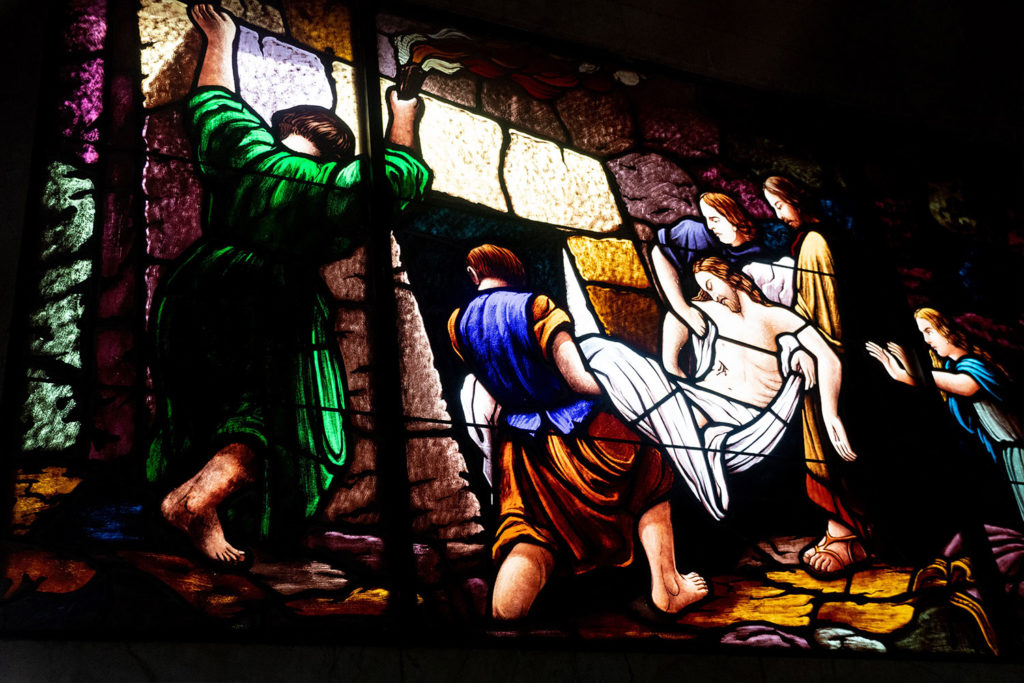Answering Common Objections to the Historical Accuracy of the Gospel Accounts of Jesus’ Trials and Execution
By Craig Blomberg
Strange as it may sound, the most certain thing about the life of Jesus of Nazareth is his death. Even the Roman historian, Tacitus, writing in the early second century, observed that Christians received their name from “Christ who had been executed by sentence of the procurator Pontius Pilate in the reign of Tiberius” (Annals 15.44). The first-century Jewish historian, Josephus, agreed, remarking that “when Pilate, upon hearing him accused by men of the highest standing amongst us, had condemned him to be crucified, those who had in the first place come to love him did not give up their affection for him” (Jewish Antiquities 18.63-64). Several hundred years later, the Jewish (Babylonian) Talmud reflected a garbled memory of the Jewish leaders’ involvement in Jesus’ death. It declared that Jesus was hanged on the eve of Passover and that ‘for forty days before the execution took place, a herald went forth and cried, ‘He is going forth to be stoned because he has practiced sorcery and enticed Israel to apostasy'” (b. Sanhedrin 43a).
Within the New Testament accounts of Jesus’ arrest, trials and crucifixion (the so-called Passion Narratives), however, there are a number of details that skeptics over the years have questioned. One category involves apparent violations of Jewish law concerning the trial and execution of a capital offender. These include holding a trial on a Sabbath evening (indeed during festival-time more generally), at night, without witnesses on behalf of the accused, and with the high priest speaking before those with lower authority spoke. It is, of course, possible that these latter two features were present and that none of the Gospels happened to narrate them, but this approach cannot account for the timing of the trial, the most egregious of the apparent legal violations.
At least five replies are in order. First, the oldest document containing Jewish legislation concerning such trials is the Mishnah, the codification of oral traditions that had been developing for centuries, published in about A.D. 200. There is no way to know if any or all of these laws on this topic were already in existence in Jesus’ day, though many of the Mishnaic laws probably were. Second, these laws applied directly to the beth din, the second- and third-century Jewish court, which did not always do things exactly the way the Sanhedrin (the “supreme court” in pre-A.D. 70 Jerusalem) had done them. Third, the Mishnah represents, in most cases, the legacy of the Pharisaic wing of Judaism, the only one to have survived the fall of Jerusalem to Rome in 70, whereas in Jesus’ day the Sadducees, who often promoted different laws, held the majority on the Sanhedrin. Fourth, even later Jewish literature (the Tosefta) does allow at times for the trials during festivals of those accused of seducing others to idolatry or of being false prophets (t. Sanhedrin 10.11 and 11.7). Finally, leaders desperate to do away with someone they perceive as a serious threat will often violate even what existing laws they may otherwise follow. With all of these variables, it is difficult to see how one could mount a convincing case that the Sanhedrin could not have acted as the Gospels claim they did.1
A second kind of problem involves apparent contradictions among the New Testament Gospels themselves. Most notable are the distinctive elements of John’s account. The biggest problem involves John’s apparently contradictory chronology. The Synoptic Gospels very clearly portray Jesus celebrating the Passover with his disciples the last night of his life (Matt. 26:17, 19; Mark 14:12, 14; Luke 22:7-8), whereas a superficial reading of John has led many to assume that the Fourth Gospel places the Last Supper one day earlier. On this reading, John states that the Last Supper was before the Passover (13:1), portrays the disciples thinking that Judas has left the meal to buy something for the upcoming Passover feast (13:29), says that the Jewish leaders did not want to defile themselves by entering a Gentile palace prior to eating the Passover (18:28), and refers to that day as the day of Preparation, presumably for the Passover (19:14, 31). This line of interpretation then makes it very attractive to see the reference in 19:14 to it being the sixth hour (noon) as John’s way of highlighting Jesus as the Lamb of God, because it was at this time that the lambs for the evening Passover feasts would have been slaughtered.
On closer inspection, however, not one of these conclusions seems the most exegetically probable. John 13:1 actually states that it was before the Passover when Jesus knew that his hour had come. Verses 1-2 then naturally describe the love Jesus had for his disciples already before that festival.2 When John then turns in the rest of the chapter to describing in detail Jesus’ teaching and actions at his last supper, it is at least as natural to assume that now we have come to the Passover. Verse 29 would then refer to Judas purchasing something for the rest of the week-long feast. After all, if this were a full 24 hours before the Passover, he could easily have made the purchases the next morning during normal market hours. But on the night of Passover, shops and stalls stayed open later and it was considered meritorious to give alms (in money or in kind) to the poor.3
John 18:28 actually makes better sense on the assumption that the main, initial meal of the Passover had occurred the night before. Ritual uncleanness due to entering an unclean house typically only lasted until the end of that day, and Jews calculated each day from sundown to sundown. So, if the Jewish leaders were worrying about not being able to eat the Passover after dark that night, then their worry seems unnecessary; the new day would have rendered them clean. But if they were concerned about the hagigah, the special lunch served midday after the start of Passover, then the text makes good sense. Indeed, the Mishnah would later devote an entire tractate to mid-festival days (Moed Katan) and another to the festal offerings (Hagigah), including the offerings brought in between the first and last days of feasts (e.g., Hag. 1.3).4
As for John 19:14 and 31, the “day of Preparation” could refer to preparing for the Passover, but it more likely refers to preparing for the Sabbath. Verse 31 makes it explicit that the next day was to be a Sabbath, so both verses may well be using the term in that sense only. Even to this day, Paraskeuê in Greek is the standard name for Friday, the day before Saturday, the Jewish Sabbath. With respect to Lamb-of-God typology, it is true that the Fourth Evangelist is the only New Testament writer to apply this term to Jesus, but most of the references come in Revelation. In his Gospel, John uses the term only in chapter 1. If John had intended the passing reference to noon in 19:14 to highlight Jesus as the true Passover lamb, John kept his reference about as brief and cryptic as he possibly could have. It is not good method to allow this possible allusion to dictate the interpretation of the rest of the Passion Narrative’s chronology.5
Several other supposed contradictions can be resolved more readily. Only John refers to the Roman soldiers (literally, a “cohort”) accompanying the Jewish temple guard for Jesus’ arrest, which some critics have found improbable. But the volatile political climate of a Passover, the need to be “in sync” with the Roman governor’s wishes, and the need for the Jewish leaders to pass Jesus on to the Romans for execution anyway, all combine to make this extra contingent of soldiers plausible. Technically, Annas is the ex-high priest, not the high priest, who was Caiaphas (contrast 18:13), but since in Jewish law the priesthood was for life, Rome’s deposition of Annas and several of his sons prior to its installation of his son-in-law would not have prevented Annas from being addressed with this term of traditional respect. The additional information involving Jesus’ trial before Pilate merely supplements but in no way contradicts the Synoptics. Indeed, John’s unique additions-the emphasis on formal charges (18:29, 38; 19:4) and condemnation (19:19-21), the reference to Pilate as “Caesar’s friend” (19:12), and the use of the tribunal seat (19:13)-all fit in with known Roman practices.6
Finally, there is the puzzling “contradiction” concerning the time of the beginning of Jesus’ crucifixion. Was it the third (Mark 15:25) or sixth (John 19:14) hour (i.e., 9 A.M. or 12 noon)? Probably it occurred some time in between. In the ancient world, with sundials as the most precise device available for measuring time, many people referred simply to quarters of the day (or night). The third hour could simply mean mid-morning, while the sixth hour could encompass a much broader swath of time both before and after the moment the sun was directly on high. Moreover, cultures spoke of the beginning of events very imprecisely; a meeting advertised for what we would call 10:00 A.M. might not actually start until after noon (a practice still observable in parts of the world)!7 Better therefore to recognize that both Gospel writers are simply using terminology for time loosely, in accordance with the standards of their day rather than ours.
Even more minor difficulties could be enumerated and plausible resolutions offered. But these should suffice to demonstrate that the “Passion problems” some skeptics tout do not merit the weight given to them. All find reasonable solutions that fair-minded inquirers should accept.
Notes
1The best detailed defense of the historicity of the numerous questionable elements in the trial accounts remains Josef Blinzler, The Trial of Jesus (Westminster, Eng.: Newman; Cork, Ire.: Mercier, 1959).
2Herman N. Ridderbos, The Gospel according to John: A Theological Commentary (Grand Rapids: Eerdmans, 1997), 452, 455.
3D. A. Carson, The Gospel according to John (Grand Rapids: Eerdmans; Leicester: InterVarsity, 1991), 475.
4Cf. esp. Barry D. Smith, “The Chronology of the Last Supper,” Westminster Theological Journal 53 (1991): 29-45.
5Cf. further Cullen I. K. Story, “The Bearing of Old Testament Terminology on the Johannine Chronology of the Final Passover of Jesus ,” Novum Testamentum 31 (1989): 316-24.
6F. F. Bruce, “The Trial of Jesus in the Fourth Gospel,” in Gospel Perspectives, vol. 1, ed. R. T. France and David Wenham (Sheffield: JSOT; Eugene, OR: Wipf & Stock, repr. 2003), 7-20.
7Gerald L. Borchert, John 12-21, New American Commentary (Nashville: Broadman & Holman, 2002), 258.
Published March 30, 2016




